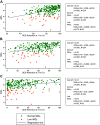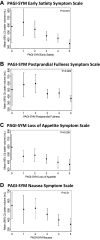Relationships among intragastric meal distribution during gastric emptying scintigraphy, water consumption during water load satiety testing, and symptoms of gastroparesis
- PMID: 37552206
- PMCID: PMC10887845
- DOI: 10.1152/ajpgi.00065.2023
Relationships among intragastric meal distribution during gastric emptying scintigraphy, water consumption during water load satiety testing, and symptoms of gastroparesis
Abstract
Gastric emptying scintigraphy (GES) measures total gastric retention after a solid meal and can assess intragastric meal distribution (IMD). Water load satiety test (WLST) measures gastric capacity. Both IMD immediately after meal ingestion [ratio of proximal gastric counts after meal ingestion to total gastric counts at time 0 (IMD0)] and WLST (volume of water ingested over 5 min) are indirect measures of gastric accommodation. In this study, IMD0 and WLST were compared with each other and to symptoms of gastroparesis to gauge their clinical utility for assessing patients with symptoms of gastroparesis. Patients with symptoms of gastroparesis underwent GES to obtain gastric retention and IMD0, WLST, and filled out patient assessment of upper GI symptoms. A total of 234 patients with symptoms of gastroparesis were assessed (86 patients with diabetes, 130 idiopathic, 18 postfundoplication) and 175 (75%) delayed gastric emptying. Low IMD0 <0.568 suggesting initial rapid transit to the distal stomach was present in 8% and correlated with lower gastric retention, less heartburn, and lower volumes consumed during WLST. Low WLST volume (<238 mL) was present in 20% and associated with increased severity of early satiety, postprandial fullness, loss of appetite, and nausea. Low IMD0 is associated with less gastric retention and less heartburn. Volume of water consumed during WLST, while associated with IMD0, has associations with early satiety, postprandial fullness, loss of appetite, and nausea. Thus, IMD0 and WLST appear to overlap somewhat in their assessment of gastric physiology in adults with symptoms of gastroparesis but relate to different dyspeptic symptoms.NEW & NOTEWORTHY IMD0 and WLST were assessed for their clinical utility in assessing patients with symptoms of gastroparesis. Low IMD0 is associated with less gastric retention and less heartburn. Volume of water consumed during WLST, while associated with IMD0, has associations with early satiety, postprandial fullness, loss of appetite, and nausea. IMD0 and WLST appear to overlap somewhat in their assessment of gastric physiology in adults with symptoms of gastroparesis but relate to different dyspeptic symptoms.
Keywords: early satiety; gastric emptying; gastroparesis; idiopathic gastroparesis.
Conflict of interest statement
No conflicts of interest, financial or otherwise, are declared by the authors.
Figures



Similar articles
-
Postprandial symptoms in patients with symptoms of gastroparesis: roles of gastric emptying and accommodation.Am J Physiol Gastrointest Liver Physiol. 2022 Jul 1;323(1):G44-G59. doi: 10.1152/ajpgi.00278.2021. Epub 2022 May 3. Am J Physiol Gastrointest Liver Physiol. 2022. PMID: 35502871 Free PMC article.
-
Intragastric Meal Distribution During Gastric Emptying Scintigraphy for Assessment of Fundic Accommodation: Correlation with Symptoms of Gastroparesis.J Nucl Med. 2018 Apr;59(4):691-697. doi: 10.2967/jnumed.117.197053. Epub 2017 Sep 28. J Nucl Med. 2018. PMID: 28970332 Free PMC article.
-
Proximal and distal intragastric meal distribution during gastric emptying scintigraphy: Relationships to symptoms of gastroparesis.Neurogastroenterol Motil. 2022 Dec;34(12):e14436. doi: 10.1111/nmo.14436. Epub 2022 Aug 5. Neurogastroenterol Motil. 2022. PMID: 35929769
-
Gastroparesis: definitions and diagnosis.Gastroenterol Clin North Am. 2015 Mar;44(1):1-7. doi: 10.1016/j.gtc.2014.11.001. Epub 2014 Dec 24. Gastroenterol Clin North Am. 2015. PMID: 25667018 Review.
-
2023 update on the clinical management of gastroparesis.Expert Rev Gastroenterol Hepatol. 2023 May;17(5):431-441. doi: 10.1080/17474124.2023.2196404. Epub 2023 Mar 29. Expert Rev Gastroenterol Hepatol. 2023. PMID: 36970885 Review.
Cited by
-
Current Concepts in Gastroparesis and Gastric Neuromuscular Disorders-Pathophysiology, Diagnosis, and Management.Diagnostics (Basel). 2025 Apr 5;15(7):935. doi: 10.3390/diagnostics15070935. Diagnostics (Basel). 2025. PMID: 40218285 Free PMC article. Review.
-
Gastric Myoelectrical Activity Patterns and Water-Load Satiety Test in Patients With Chronic Dyspeptic Symptoms.JGH Open. 2025 Jun 4;9(6):e70189. doi: 10.1002/jgh3.70189. eCollection 2025 Jun. JGH Open. 2025. PMID: 40475111 Free PMC article.
References
-
- Pasricha PJ, Colvin R, Yates K, Hasler WL, Abell TL, Unalp-Arida A, Nguyen L, Farrugia G, Koch KL, Parkman HP, Snape WJ, Lee L, Tonascia J, Hamilton F. Characteristics of patients with chronic unexplained nausea and vomiting and normal gastric emptying. Clin Gastroenterol Hepatol 9: 567–576.e1–e4, 2011. doi:10.1016/j.cgh.2011.03.003. - DOI - PMC - PubMed
-
- Pasricha PJ, Grover M, Yates KP, Abell TL, Bernard CE, Koch KL, McCallum RW, Sarosiek I, Kuo B, Bulat R, Chen J, Shulman RJ, Lee L, Tonascia J, Miriel LA, Hamilton F, Farrugia G, Parkman HP; National Institute of Diabetes and Digestive and Kidney Diseases/National Institutes of Health Gastroparesis Clinical Research Consortium. Functional dyspepsia and gastroparesis in tertiary care are interchangeable syndromes with common clinical and pathologic features. Gastroenterology 160: 2006–2017, 2021. doi:10.1053/j.gastro.2021.01.230. - DOI - PMC - PubMed
-
- Orthey P, Yu D, Van Natta ML, Ramsey FV, Diaz JR, Bennett PA, Iagaru AH, Fragomeni RS, McCallum RW, Sarosiek I, Hasler WL, Farrugia G, Grover M, Koch KL, Nguyen L, Snape WJ, Abell TL, Pasricha PJ, Tonascia J, Hamilton F, Parkman HP, Maurer AH; NIH Gastroparesis Consortium. Intragastric meal distribution during gastric emptying scintigraphy for assessment of fundic accommodation: correlation with symptoms of gastroparesis. J Nucl Med 59: 691–697, 2018. doi:10.2967/jnumed.117.197053. - DOI - PMC - PubMed
Publication types
MeSH terms
Grants and funding
LinkOut - more resources
Full Text Sources

